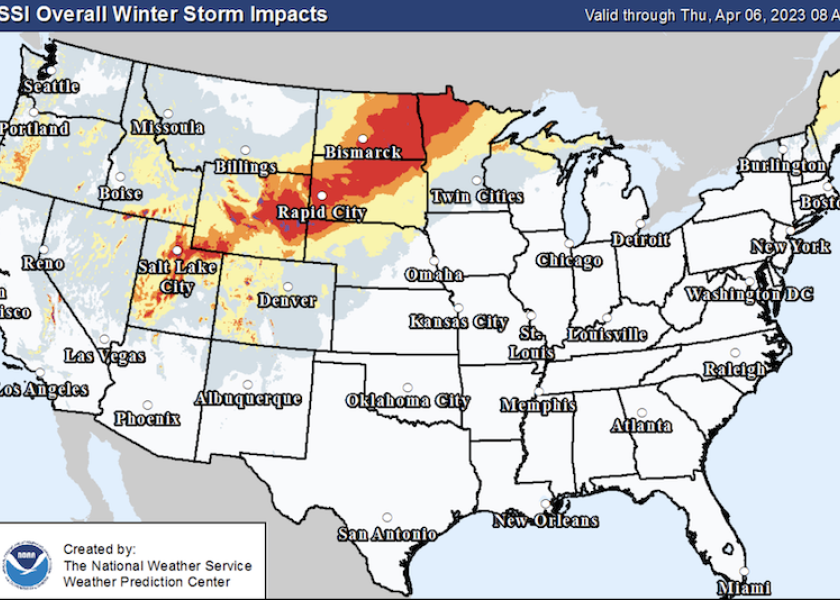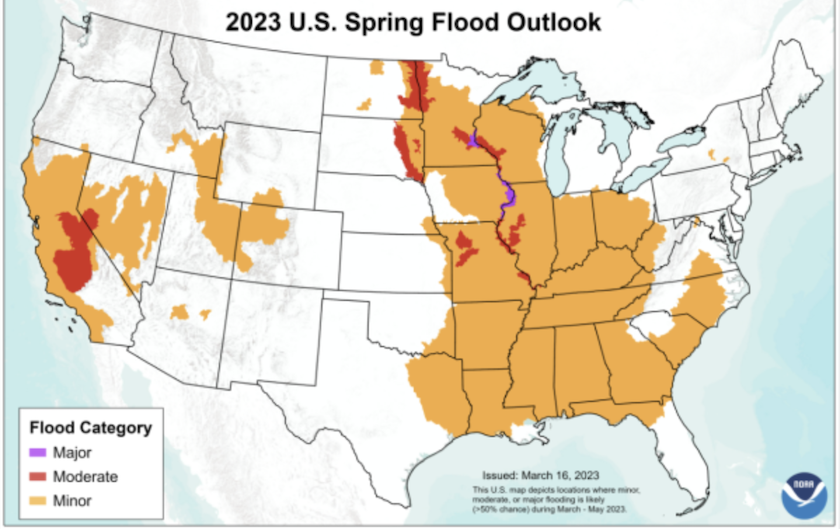Prevent Plant Concerns Heat Up As the Upper Midwest Could See the Worst Winter Storm of the Year

Two to three feet of snow is forecast to fall over parts of South Dakota, North Dakota and Minnesota this week. The area is already seeing historic snowpack, and with another storm on the way, some market watchers are beginning to question if 92 million acres of corn can actually get planted this year.
It's been a long winter for those in the upper Midwest, and this week's forecast could bring the biggest winter storm yet. The storm is also bringing 40 to 50 mph winds, which will make it tough for ranchers and cattle producers in the middle of calving season. Blizzard warnings have been issued for six states, including Wyoming, northeast Nebraska, South Dakota, North Dakota and Minnesota.
A significant April snowstorm is set to begin across the Intermountain West, central Rockies, and parts of the central High Plains today before spreading into the northern Plains and Upper Midwest on Tuesday. See the latest Key Messages for more information. pic.twitter.com/C6n9iS5ij5 — NWS Weather Prediction Center (@NWSWPC) April 3, 2023
⚠️ STORM UPDATE FOR MONDAY NIGHT - WEDNESDAY
- Travel impacts are expected, worsening further north and west where a blizzard is possible.
- The heaviest snow has shifted northwest, but 40-50+ mph gusts are expected!
Continue to monitor the forecast for updates! pic.twitter.com/mdvjZLekni — NWS Sioux Falls (@NWSSiouxFalls) April 2, 2023
The late winter storm comes on the heels of USDA's Prospective Plantings Report on Friday. USDA’s March plantings report showed farmers plan to plant more corn than soybeans this year.
- Corn: 91.9 million, up 4% from 2022
- Soybeans: 87.51 million, up slightly from 2022
- All Wheat: 49.9 million, up 9% from 2022
- Cotton: 11.3 million, down 18% from 2022
USDA also projects 318.1 million acres of principle crops to be planted this year. That’s 6 million more acres than in 2022 and nearly 1 million more acres than farmers planted in 2021.
A powerful snowstorm will evolve into a dangerous blizzard and drop more than 2 feet of snow across parts of the north-central US this week: https://t.co/T4WCyYiDMz pic.twitter.com/ESQlcbmsq0 — Breaking Weather by AccuWeather (@breakingweather) April 3, 2023
Peter Meyer of S&P Global Commodity Insights says the thing to watch is where farmers plan to plant more corn, especially in the northern tier of states that are facing historic snowfall and winter moisture, with another winter storm on the way.
"It's where the corn acres sit, 1.3 million acres in North Dakota, South Dakota and Minnesota, which from all indications farmers will not be able to get into the field to plant until mid-April when the temperature breaks," Meyer says. "They're looking at record snowpack with more cold temperatures coming. But USDA's report does makes sense, because economically speaking, farmers should be planting corn."
USDA shows North Dakota's corn acres could be up a whopping 27% from last year.

It's still early in the year, but with the latest winter storm forecast, along with flood forecasts already pointing to an elevated risk of flooding this year in parts of the Midwest, conversations about possible prevent plant are also surfacing.
Tregg Cronin, a farmer and market analyst in South Dakota, says it’s too early to talk about prevent plant, but he points out conditions are ripe for planting delays across North Dakota, South Dakota, Minnesota and Wisconsin.
“If we're experiencing the same weather conditions three weeks from now, I don't think it's going to be a stretch, and we will have some prevent plant this year. That's almost a certainty in some regions,” Cronin said two weeks ago on U.S. Farm Report. “The other thing to remember is a lot of our area ended the year fairly empty on soil moisture. A lot of what we've seen this winter has gone in the ground, so I think we're going to see a nice recharge of soil profiles.”
MORE Snow in the Northern US? + Crude Rally https://t.co/Tz9pdaIjgf via @YouTube #corn #soybeans #wheat #crudeoil #USDA pic.twitter.com/hB17Pjdd4w — Joe Vaclavik (@StandardGrain) April 3, 2023
As a farmer in an area of South Dakota that was plagued with drought conditions in 2022, Cronin says he’s more concerned about recharging the moisture in his soils than he is about getting into the field at this point in the season. However, there’s a caveat.
"If these forecasts don't change, and we're into the middle of April and still looking at below-normal temperatures and snow to melt, then prevent plant discussions are really going to ramp up, which will be interesting with acres already so tight for everything from specialties to corn to soybeans to wheat,” Cronin says. “Everybody needs acres this year. If it does play out over the next few weeks, you're going to start to see markets get a little bit jumpy, I think.”
Just a wee bit of snow in the field 😂❄️ pic.twitter.com/p3uyyEJ01l — 👣 Bare Footn’ Farmer 🇺🇸 (@LouieDN) April 1, 2023
Dan Bosse of Bolt Marketing also resides in South Dakota, an area that was concerned about planting issues even before this week's storm.
“With the snowpack up here, and a possibly colder start to the spring, that really puts into question spring wheat acres, and the market’s job might be to make sure those acres get planted. Usually that means higher prices,” Bosse says. “But to Tregg’s point, we are a little early to talk about planting delays. We don't usually see a rally until the May timeframe when the progress reports come out and they show we're behind.”
There have been reports of farmers who increased their prevent plant coverage, which could be another sign farmers in the northern Corn Belt are worried about planting issues this spring.

NOAA’s spring flood outlook says snow water equivalent values (SWE) across the upper Mississippi River are the biggest factor leading to their projection of possible flooding this year due to spring melt.
As of March 20, 2023, the SWE amounts across northern and central Minnesota were between 5 and 7 inches. In Wisconsin, that amount is between 6 to 8 inches.
“These values are in the top 10% to 20% of the historical record and are the primary driver of the above-normal chance of flooding along the Mississippi River,” NOAA said in its outlook. “SWE values significantly drop along a line from roughly Austin, Minn. to Wausau, Wis.”







